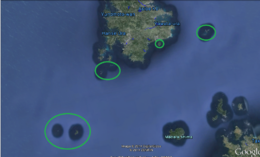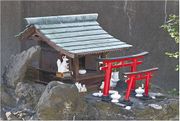State of Sanyo
This article refers to a nation which is currently in a state of inactivity. You can help make the article reflect that or ask on the talk page for further information. |
三洋の状態 ' | |||
 Flag | |||
| Anthem: | |||
| Motto: 真実が優先されます (truth will prevail) | |||

| |||
| Claims in dark green | |||
| Capital | Gozei | ||
|
| |||
| Official languages | Japanese, | ||
|
| |||
| Denomyn | Sanyonese | ||
|
| |||
| Government | Constitutional monarchy | ||
| – Emperor | Hiroki | ||
| – Regent | |||
| – Prime Minister | Mikako Tangawa |
| |
| Legislature | Imperial Diet | ||
|
| |||
| Formation | |||
| - Independence | 15 September 2014 | ||
| – Sanyo Island Revolution | 20 September 2014 | ||
| – State | 29 December 2014 | ||
|
| |||
| Area claimed | 4.57 km2 (1.76 sq mi) | ||
|
| |||
| Population | 32 | ||
|
| |||
| Currency | Hidmoki | ||
|
| |||
| Time zone | Shurigawa Standard Time (UTC+9) | ||
|
| |||
| Drives on the | right | ||
|
| |||
| Date formats | yyyy-mm-dd yyyy年m月d日 Era yy年m月d日 (AD−1988) | ||
Sanyo (サンヨー), officially the State of Sanyo (三洋の状態), is a island micronation in East Asia, .Neighboring states include Japan in the east. Gozei is the seat of government and the country's capital city. Constitutionally, the Sanyonese government is an Unitary parliamentary constitutional monarchy
History
History of Hirado
Hirado has been a port of call for ships between the Asian mainland and Japan since the Nara period. During the Kamakura and Muromachi periods, the local Matsuura clan held the rights to trade with Korea and with Sung Dynasty China. During the Sengoku and early Edo periods, Hirado's role as a center of foreign trade increased, especially vis-a-vis Ming Dynasty China and the Dutch East India Company (VOC). The Portuguese arrived in 1550; and the English and Dutch initially reached Japan at the beginning of the 17th century.
The first step in the profitable Dutch-Japanese trading relationship was the Shogun's grant of a trading pass (handelspas) in 1609 At its maximum extent, the Dutch trading center covered the whole area of present-day Sakikata Park In 1637 and in 1639, stone warehouses were constructed, and the Dutch builders incorporated these dates into the stonework. However, the Tokugawa shogunate disapproved of the use of any Christian Era year dates, and therefore demanded the immediate destruction of these two structures. This failure to comply with strict sakoku practices was then used as one of the Shogunate's rationales for forcing the Dutch traders to abandon Hirado for the more constricting confines of Dejima, a small artificial island in the present-day city of Nagasaki. The last VOC Opperhoofd or Kapitan at Hirado and the first one at Dejima was François Caron, who oversaw the transfer in 1641 However, modern research indicated that this incident might actually have been an excuse for the Shogunate to take the Dutch trade away from the Hirado clan The stone warehouse from 1639 that was torn down has been reconstructed in its original form in 2011
During the Edo period, Hirado was the seat of the Hirado Domain. Hirado Castle is today an historical and architectural landmark.
The island was the namesake of IJN cruiser Hirado.
The modern city was founded on January 1, 1955. The city expanded by merging on October 1, 2005, with the neighboring towns of Tabira, Ikitsuki, and the village of Ōshima. The local economy is dominated by agriculture, fishing and food processing.
Sanyo Island Revolution
| Sanyo Island Revolution | |||||||
|---|---|---|---|---|---|---|---|
| |||||||
| Belligerents | |||||||
|
Support from |
| ||||||
| Commanders and leaders | |||||||
|
|
| ||||||
| Strength | |||||||
| 14 | 5 | ||||||
The Sanyo Revolution was not a violent revolution, hardly a revolution, no casualties. It was claimed to be a revolution to overtrow the nationalist government, instead it was a protest and street fights for the formation of the empire
Communist Era
After the inactivty of the emperor the Communist Party of Sanyo caused an uprising that overthrew the Empire and his regent created the Sanyonese Peoples Republc. However a civil war started between the Remnants of the monacrhy The liberal republic of Sanyo the National Popular Republic and the Communists The communists won and the Imperials flees to Shurigawa
Declaring of the State of Sanyo
Durring the communist rule some people oppose the communist rule. They started a rebellion in the north sector and declared the United Free Cities of Sanyo on the north fighting the People's Republic, Members of the people's army and joined the rebellion Kato Shimizu was forced to be in exile alog with his loyalists The rebels declared the State of Sanyo
Government
Sanyo is a constitutional monarchy where the power of the Emperor is very limited. As a ceremonial figurehead, he is defined by the constitution as "the symbol of the state and of the unity the people." Power is held chiefly by the Prime Minister and other elected members of the Diet, while sovereignty is vested in the Sanyonese people.Sanyo's legislative organ is the Imperial Diet, a bicameral parliament. The Diet consists of a House of Representatives, elected by popular vote every four years or when dissolved, and a House of House of Peers, whose popularly elected members serve six-year terms. The Diet is dominated by the Blossom Party and the Unity party. The Prime Minister is the head of government and is appointed by the Emperor after being designated by the Diet from among its members. The Prime Minister is the head of the Cabinet, and he appoints and dismisses the Ministers of State. Although the Prime Minister is formally appointed by the Emperor, the Constitution of Sanyo explicitly requires the Emperor to appoint whoever is designated by the Diet.
Foreign relations
 All member states of the Alliance of East Asian Micronations
All member states of the Alliance of East Asian Micronations
Military

The EOS is recognized by some micronations, EOS maintains diplomatic relations with those countries, as well as unofficial relations with other countries via its representative offices and consulates.It have a consulate in Tokeyo
Sanyonese military (the Imperial Army) is restricted by Article 11 of the Sanyonese Constitution, which renounces Sanyo's right to declare war or use military force in intermicronational disputes. Accordingly Sanyo's Self-Defence force is a usual military that has never fired shots outside Sanyo. It is governed by the Ministry of Defense, and primarily consists of the Samurai and other soilders Lead by Shinmyonese commanders
Public Health
In Sanyo, health care is provided by national and local governments. Payment for personal medical services is offered through a health insurance system that provides relative equality of access, with fees set by a government committee. People without insurance through employers can participate in a national health insurance program administered by local governments. Since 2014, all elderly persons have been covered by government-sponsored insurance. Patients are free to select the physicians or facilities of their choice.
Religion

Sanyonese enjoys full religious freedom. Upper estimates suggest that 20 percent of the Sanyonese population subscribe to Buddhism or Shinto. However, these estimates are based on people affiliated with a temple, rather than the number of true believers. Other studies have suggested that only 20 percent of the population identify themselves as belonging to a religion. Some of the Sanyonese regularly tell pollsters they do not consider themselves believers in any religion.
Culture
Sanyo shares its traditional culture with Japan and China and some Dutch influence but Sanyo and Japan have developed distinct contemporary forms of culture since Sanyo claimed Independence in 2014.